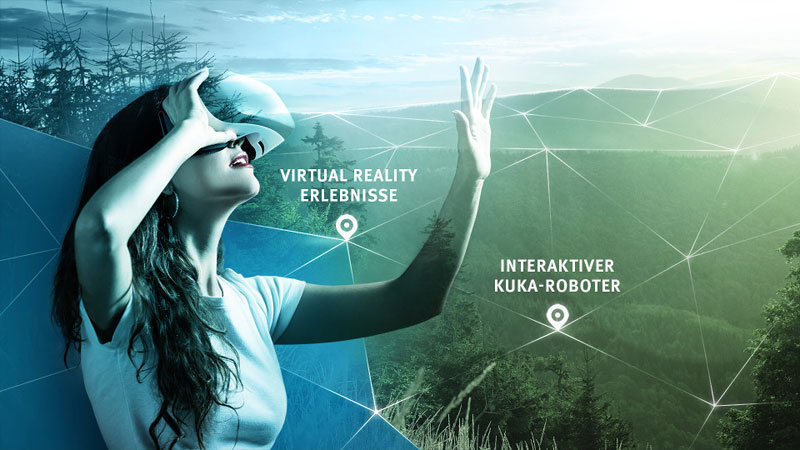Visit the state capital Erfurt and go on a virtual discovery tour through Thuringia.
Treasures of history, archaeology and art
Museum of Cultural History Mühlhausen
The Museum of Cultural History is the place in Mühlhausen where all the colourful, sometimes even dramatic aspects of the varied history of the city and the region can be explored – in an expertly staged authentic atmosphere. The building was completely renovated ten years ago. The carefully thought out educational concept of the museum and the selection of exhibits give you a sense of the extent to which the dedicated team poured their heart and soul into the individual departments.
I am amazed by what I have seen
For visitors interested in city politics, the first and largest area, “ImperialCITY”, is very informative as Mühlhausen held the extraordinary status of a Free Imperial City from 1251 until 1802/03. Find out what freedoms, rights and obligations existed when a city was under the direct authority of the emperor and was allowed to govern itself autonomously. A progressive characteristic of this was that the upper middle class was entrusted with the regulation of the city’s affairs. In this context, you will also learn something about the almost ubiquitous history of Mühlhausen’s aldermen, which you will encounter over and over again as you explore the city – in attractions such as the historic town hall or St. Mary’s Church. The residents of free imperial cities generally achieved prosperity more easily, which cause the local areas to grow more quickly and also had an effect on the urban landscape with buildings that were sophisticated for the time.
Mühlhausen has always been a “churchCITY”. Eleven Gothic churches were built in the Middle Ages alone – half of which are no longer used for religious purposes. In the first half of the 13th century, the Franciscans built a monastery here – the Corn Market Church, which is still preserved to this day, bears witness to this – and the Teutonic Knights acquired property in the city in 1227. The theologian and radical Thomas Müntzer preached in the local St. Mary’s Church as one of the protagonists of the German Peasants’ War of 1525. Bad Frankenhausen and Mühlhausen played a crucial role in this event in Thuringia, which was related to the issue of "freiheyt" (freedom) in the early modern era and had a lasting impact. If you subsequently visit the St. Mary’s Museum | Müntzer Memorial in the secularised St. Mary’s Church and the Peasants’ War Museum in the Corn Market Church, both of which are original scenes of the war, you are sure to take a very emotional journey back to the turbulent year of 1525.
In the “civilCITY” area, you will be introduced to well-known Mühlhausen personalities who are either closely linked to the historical events in the city or enriched the world with their skills. The Mühlhausen-born engineer and bridge builder Johann August Roebling emigrated to the USA in the 1830s. There he designed, amongst other things, the famous Brooklyn Bridge in New York. Friedrich August Stüler, a scion of a patrician family in Mühlhausen, was the architect responsible for unforgettable construction projects in the 19th century such as the Neues Museum on Berlin’s Museum Island, which is a UNESCO World Heritage Site. The composer and musician Johann Sebastian Bach only lived in Mühlhausen for around a year, but left the city an eternal musical monument: it was here that he composed the popular cantata “Gott ist mein König” (God is my King), composed for the opening session of the newly elected city council.
The exhibition ends with “IndustrialCITY”. In the past, Mühlhausen was, for example, a centre for microelectronics – as well as for the milling industry and branches of the textile industry. The origins of these industries go back as far as the Middle Ages. Wool-processing enterprises, sewing factories and tanneries in particular experienced their heyday from the 19th, and in some cases even in the 20th, century. There was even a cigar factory. Some of the exhibits will bring a “nostalgic smile” to your face – for example the models of the first pocket calculators from the 1970s, or a school satchel or bicycle of a well-known East German brand.
Discovering the past with modern eyes
The Unstrut-Hainich-Kreis is amongst the areas of Thuringia with most finds from the Neolithic period to the Early Middle Ages. Only a small part of the full collection of 300,000 individual items is shown, including some special exhibits. You can see coins, jewellery and other excavated finds such as receptacles and metal objects from more than 6,000 years ago and find out what research has revealed about this period so far. The central theme revolves around “migration and mobility” in pre- and early history and around the far-reaching economic and technical changes that were associated with this. Objects in the context of the customs relating to “trading and communicating” are also presented.
Keeping an eye on Thuringia
Art lovers will be delighted by the alternating works, primarily oil paintings and graphic prints from the 19th to the 21st century. The artists have a connection to Thuringia, either because they were born or lived there or because they dealt with the region in their works. Pictures by Oswald Baer, a proponent of the “New Objectivity” movement, or Ali Kurt Baumgarten’s “Judaskuss” (Judas Kiss) are also exhibited there. One of the many portraits that Otto Dix, born in Gera, painted of his mother shortly before her death is a poignant exhibit in the art gallery.
Guiding children through history
One focus of the museum is on making the younger generation enthusiastic about topics related to cultural history. Knowledge is conveyed in a vivid and fun way at (interactive) stations. Your child is sure to enjoy dressing up as a key figure of Mühlhausen’s history and going on a trip with a discovery rucksack. Adalbert von Mühlhuasen, an eternally young nobleman from the Imperial City who has jumped out of the city’s coat of arms, shows the children where there is something special in store for them. The Museum of Cultural History provides a range of exciting activities for nurseries, school groups and other educational institutions.
Atmospheric walks
Do you recognise the object under the eagle on Mühlhausen’s coat of arms, which you can find in the Museum of Cultural History? It is difficult to make it out, but it is hardly surprising: it is a millrind. In the past, there were 30 mills across the city, but only a few ruins remain today. The almost three-kilometre-long medieval city wall, which can be walked from spring to autumn, is almost completely preserved. You can begin a fascinating walk right in front of the Museum of Cultural History – an absolute must during a visit to Mühlhausen. In the winter, the best time for a visit is the Advent season – Kristanplatz, in front of the museum building, is one of the many locations for the stalls of Mühlhausen’s extended atmospheric Christmas market.
In the State Exhibition, the progressive phases of the German Peasants’ War will be shown from a transregional perspective. The Museum of Cultural History is part of the Thuringian State Exhibition 2025 – and the third of the four succinct stops in the medieval imperial city of Mühlhausen. In its special exhibition, the museum addresses the impact of the German Peasants’ War on cultural memory. The next and final stop is in the All Saints Church Museum.
Header: ©Florian Trykowski, Thüringer Tourismus GmbH
Graphic in the website block: Sebastian Köpcke, Mühlhäuser Museen
Accessibility
Did you like this story?
You might also be interested in ...













